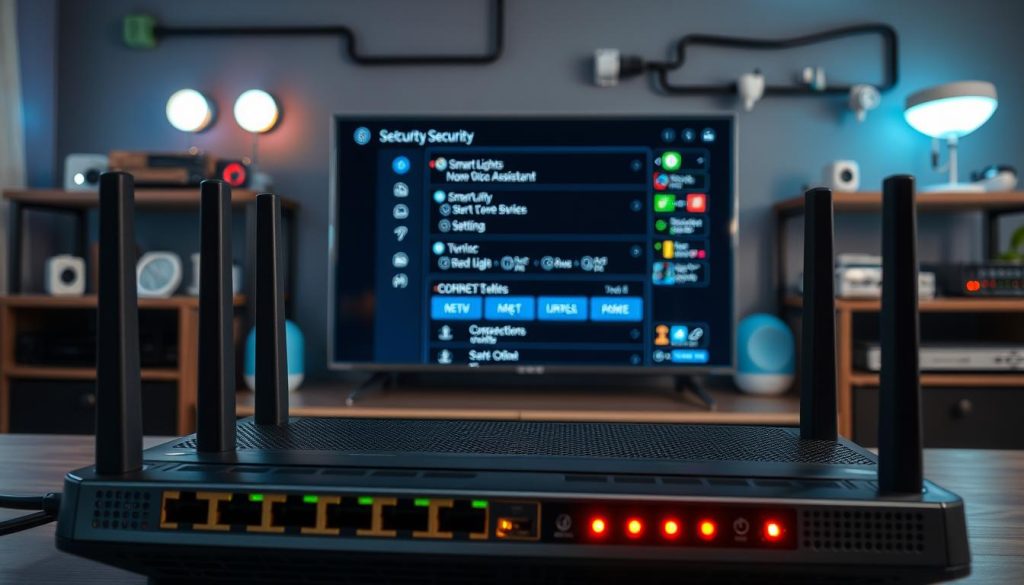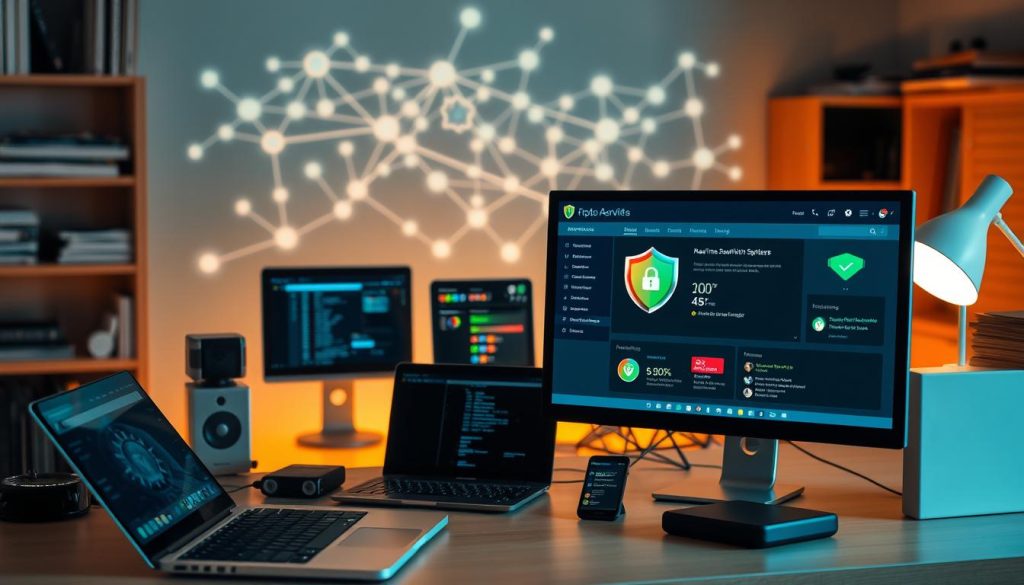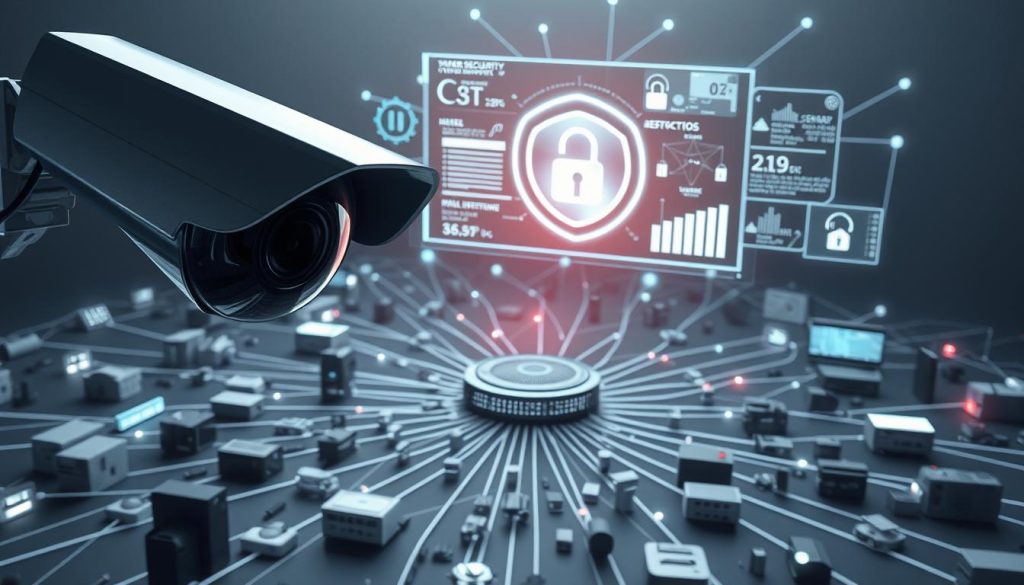Do you use your smart TVs and streaming devices for fun? But have you thought about their risk to cyber threats? Cybercriminals are increasingly targeting these devices, using their internet connection for evil deeds.
Automated attacks are getting more common. These attacks use networks of infected devices. Cybercriminals control these networks from afar, causing trouble, stealing data, or spreading malware. It’s vital to keep your devices safe to avoid being part of these bad networks.
Internet of Things security is a big worry as more devices connect. Knowing the dangers and how to stop botnet formation is key. It protects not just your devices but the whole internet too.
Key Takeaways
- Cybercriminals target smart TVs and streaming devices to carry out malicious activities.
- Automated attacks are on the rise, facilitated by networks of infected devices.
- Ensuring device security is crucial to prevent botnet formation.
- Understanding Internet of Things security risks is essential.
- Protecting devices helps safeguard the broader internet infrastructure.
Understanding Malware and Spyware
Keeping your IoT devices safe from cyber threats begins with knowing about malware and spyware. As you use more smart devices, the chance of them getting hacked increases. It’s key to understand these threats to keep your digital world safe.
Definition and Differences
Malware is any software made to harm or take advantage of a computer system or its user. Spyware is a type of malware that secretly collects information about someone or a company without their consent. Spyware is especially dangerous because it can lead to identity theft and secret monitoring.
Malware and spyware have different main goals. Malware aims to directly harm, like deleting files or taking control of your device. Spyware, on the other hand, quietly tries to get sensitive info like passwords, credit card numbers, or what websites you visit.
Common Types Found in Devices
Many types of malware and spyware are found in IoT devices:
- Viruses: They copy themselves, spreading to other files or devices.
- Trojans: They pretend to be safe software, but let hackers in.
- Ransomware: It locks your files, asking for money to unlock them.
- Adware: It shows unwanted ads, and might track your online activities.
- Keyloggers: They record every key you press, stealing your personal info.
Knowing about these threats is the first step to protect your IoT devices. By understanding the different kinds of malware and spyware, you can take steps to keep your devices and data safe.
The Rise of Malware on Smart Devices
The Internet of Things (IoT) is growing fast, which means more malware risks for smart devices. As more IoT devices are added, hackers have more targets. This has led to more IoT botnets, networks of hacked devices used for evil deeds.
Statistics on Threat Incidence
Malware on smart devices is a big problem now. For example, many smart TVs and streaming devices have been hacked. This lets hackers get into private info without permission.
| Type of Device | Percentage Infected | Common Malware Types |
|---|---|---|
| Smart TVs | 15% | Trojan, Spyware |
| Streaming Devices | 20% | Adware, Ransomware |
| IoT Devices | 25% | Botnets, Rootkits |
The table shows how common malware is on different devices. It shows we need strong Internet of Things security to protect us.
Growing Concerns Among Consumers
More people are worried about malware on smart devices now. They want to keep their data safe and stop botnet attacks.
To deal with these worries, knowing about malware and how it spreads is key. Being informed helps people protect their devices and keep their privacy safe.
Case Studies: Recent Malware Incidents
Many high-profile cases show how easy it is for malware to attack smart entertainment devices. Knowing about these incidents helps you understand the risks. It also helps you take steps to keep your devices safe.
Notable Smart TV Attacks
In recent years, smart TVs have been hit by malware, causing big security problems. For example, some smart TVs got malware that let hackers get into them without permission.
- Some malware turned smart TVs into botnets, used for DDoS attacks.
- Other times, malware showed unwanted ads or took user data without asking.
Streaming Device Compromises
Streaming devices have also been attacked by cyber threats. Malware has been found on many streaming devices, putting user security and privacy at risk.
Some key issues include:
- Malware that stole login credentials and other sensitive info.
- Malicious software that displayed fake ads or hijacked devices for mining cryptocurrency.
To keep your smart TVs and streaming devices safe, strong device cybersecurity is key. This means keeping your devices updated, using strong passwords, and being careful with apps you install.
By learning from these cases and taking action, you can greatly improve your IoT devices protection. This way, you can enjoy a safer viewing experience.
How Malware Infects Your Devices
Malware can get into your devices in many ways. It’s important to know how it happens. Malware often finds weak spots in your system or tricks you through phishing and social engineering.
Vulnerabilities in Operating Systems
Malware often starts with weak spots in your operating system. These can be from old software, bad coding, or the OS itself. Keeping your OS and apps updated is key to protecting your devices.
Updates often fix security holes that malware could use. Also, using strong security tools like firewalls and intrusion detection systems helps block malware and botnet attacks.
| Vulnerability Type | Description | Protection Measure |
|---|---|---|
| Outdated Software | Using older versions of software that have known vulnerabilities. | Regularly update your operating system and applications. |
| Poor Coding | Flaws in the coding of the operating system or apps. | Choose software from reputable developers who prioritize security. |
| Inherent Flaws | Fundamental design flaws in the OS or software. | Stay informed about known issues and apply patches as they become available. |
Phishing and Social Engineering Techniques
Attackers use phishing and social engineering to trick you. These methods are clever and hard to spot.
To stay safe, be careful with emails and links from unknown sources. Don’t click on suspicious links or open attachments from people you don’t know. Using strong passwords and two-factor authentication helps keep your devices secure.
Knowing how malware works and taking steps to protect your devices can lower the risk of attacks. Always check and improve your network security to keep your digital life safe.
Signs Your Device May Be Infected
In today’s world, knowing the signs of malware on IoT devices is key. Malware is getting smarter, so keeping your smart TVs and streaming devices safe is crucial.
Performance Issues
One early sign of malware is when your device starts to slow down. If your smart TV or streaming device takes longer to start, or apps freeze a lot, it might be infected. Malware often eats up system resources, causing these problems.
Unusual Pop-Ups or Ads
Seeing more pop-ups or ads than usual is another sign. If you see lots of pop-ups, especially ones that don’t match your viewing habits, your device might be infected. Some malware shows ads to make money, so these ads are unwanted.
Remote Access Indicators
Malware can let attackers control your device from afar. Look out for apps you don’t recognize or settings changes you didn’t make. In bad cases, your device might act like it’s being controlled by someone else. Keeping your device safe means watching for these signs and acting fast.
| Signs of Infection | Description | Action |
|---|---|---|
| Performance Issues | Slow startup, freezing, or crashing apps | Check for malware, update software |
| Unusual Pop-Ups or Ads | Increased, inappropriate, or unrelated ads | Run adware scans, adjust ad settings |
| Remote Access Indicators | Unfamiliar apps, unauthorized setting changes | Change passwords, enable two-factor authentication |
By knowing these signs and acting early, you can greatly improve your device’s security. This helps keep your IoT devices safe from threats.
Protecting Your Smart TV from Malware
Smart TVs are now a big part of our entertainment. It’s key to keep them safe from malware. Taking a few steps can really help protect your smart TV.
Regular Software Updates
Keeping your smart TV’s software up to date is a simple yet effective way to protect it. Manufacturers often release updates to fix security issues and improve performance. Enable automatic updates to get the latest security patches without having to check manually.
Regular updates not only boost security but also make your smart TV work better. By keeping up with updates, you get new features and stay safe from malware.
Securing Your Home Network
Securing your home network is also vital for protecting your smart TV. Your network connects all your devices, including your smart TV and computers. If your network is not secure, malware can easily spread to your devices.
To make your network safer, change your router’s default password to something strong. Use WPA3 encryption for the most secure Wi-Fi. Also, update your router’s firmware regularly. Consider setting up a guest network for IoT devices like your smart TV to keep them separate from your main network. This helps prevent malware from spreading.

By following these steps, you can greatly improve your smart TV’s security. This protects it from malware and other online threats.
Best Practices for Streaming Device Security
Securing your streaming devices is crucial for protecting your digital life. Enjoying streaming services comes with cybersecurity risks. It’s important to know these risks.
Using Strong, Unique Passwords
Using strong, unique passwords is a simple yet effective way to secure your devices. Don’t use your name, birthdate, or common words. Instead, mix uppercase and lowercase letters, numbers, and special characters. This makes it hard for others to access your device.
Tips for creating strong passwords:
- Use a password manager to generate and store complex passwords.
- Change your passwords regularly to minimize the risk of unauthorized access.
- Avoid using the same password across multiple devices or accounts.
Enabling Two-Factor Authentication
Enabling two-factor authentication (2FA) adds extra security to your devices. You’ll need a second verification, like a code sent to your phone or a biometric scan, besides your password. This makes it hard for hackers to get into your device, even with your password.
Benefits of two-factor authentication:
- Provides an additional layer of security beyond just passwords.
- Reduces the risk of unauthorized access to your device and personal data.
- Helps protect against phishing and other types of cyber attacks.
By following these best practices, you can greatly improve your streaming device security. This protects your digital life from threats.
Role of Antivirus Software on Smart Devices
Antivirus software is key to keeping your smart devices safe from cyber threats. With the Internet of Things (IoT) expanding, more devices are at risk. This makes strong antivirus protection crucial for your smart TVs and streaming devices.
Recommended Antivirus Solutions
Choosing the right antivirus software is vital for your smart devices. Here are some top picks:
- Norton Antivirus: Known for its comprehensive protection against malware and other cyber threats.
- Kaspersky Internet Security: Offers advanced security features, including anti-phishing and ransomware protection.
- Bitdefender Antivirus: Provides robust malware detection and removal capabilities.
These antivirus solutions work well with various smart devices. They help protect your IoT devices from botnet attacks and other cyber threats.

Limitations of Antivirus Protection
While antivirus software is crucial, it’s not perfect. Some malware can slip past it. This shows why you need to use antivirus software with other security steps.
| Security Measure | Description | Effectiveness Against Malware |
|---|---|---|
| Antivirus Software | Detects and removes malware | High |
| Regular Software Updates | Patches vulnerabilities in device software | High |
| Two-Factor Authentication | Adds an extra layer of security to device access | Medium |
| Network Security | Protects the network to which devices are connected | High |
Knowing how antivirus software works and its limits helps protect your smart devices. It ensures your Internet of Things (IoT) ecosystem stays safe from cyber threats.
Privacy Risks Associated with Malware
Malware on smart devices can harm your privacy. It makes you open to cyber threats. These threats can misuse your personal data.
Data and Personal Information Theft
Malware is a big risk for stealing your personal data. It can grab sensitive info like login details and financial data. This info can be used for identity theft and fraud.
Safeguarding connected devices is key to avoid these issues. Keeping your devices updated with security patches helps a lot. It lowers the chance of data theft.
Unauthorized Monitoring and Surveillance
Malware lets hackers watch your activities and device use. This is a big privacy invasion. Hackers can see your messages, browsing history, and more.
The risk of botnet attacks grows with malware. Botnets are groups of infected devices controlled by hackers. They can do DDoS attacks and spamming.
To stay safe, you need strong device cybersecurity. Use antivirus software, update your device, and be careful with apps and links.
Understanding the Legal Implications
Exploring smart TVs and streaming devices means knowing about malware and cybersecurity laws. These laws are complex and protect your personal data. They cover many areas to keep you safe online.
Laws Surrounding Cybersecurity
Cybersecurity laws are changing to fight malware and cyber threats. In the U.S., both federal and state laws apply. For example, the Cybersecurity and Infrastructure Security Agency (CISA) helps with cybersecurity efforts.
Companies must use strong network security measures to protect your data. This means devices should be secure from the start, not just added later.

Consumer Rights Against Malware
As a consumer, you have rights against malware. If your device gets malware, you might be able to get help from laws. For example, companies can be blamed for not updating security or making devices too easy to hack.
Knowing your rights and how to protect yourself is key. Learn about data protection laws in your area and IoT cybersecurity rules.
Understanding malware and cybersecurity laws helps keep you safe. It’s a big topic, but knowing your rights and the laws can protect your data and digital security.
Responding to Malware Attacks
When malware attacks your device, knowing what to do first is crucial. Your device’s safety depends on quick action. This can stop the damage before it gets worse.
Steps to Take Immediately After Infection
First, disconnect your device from the internet. This stops the malware from spreading or talking to its creators. It’s a key step to control the threat.
Run a full scan with your antivirus software. Make sure your antivirus is up to date. This helps fight off the latest threats.
If the problem is big or you’re not sure what to do, consider resetting your device to its factory settings. This will erase everything. So, back up important data before doing this, if you can.
Reporting the Incident
After stopping the malware, report the incident to the right people or your device’s support team. Reporting helps track the malware source. It also helps protect others.
For IoT devices like smart TVs and streaming devices, reporting is key. It helps manufacturers find and fix vulnerabilities. Your actions help keep the digital world safer for everyone.
When you report, give as much detail as you can. Include how you found the malware and any error messages. This info is crucial for experts fighting botnet attacks and protecting IoT devices.
By following these steps, you protect your devices and help fight malware. Being informed and proactive is essential for keeping your digital world safe.
Collaborative Efforts Against Cyber Threats
Malware and spyware are getting smarter, and we need to work together to fight them. With more devices connected online, we face a bigger risk. It’s key to share what we know to keep the Internet of Things (IoT) safe.
Role of Government Agencies
Government agencies are key in the battle against cyber threats. They make rules, give guidelines, and share important info. They can:
- Develop and implement cybersecurity standards for IoT devices
- Provide resources and support for cybersecurity awareness and education
- Facilitate information sharing between public and private sectors
Working with the private sector, they help stop malware and botnets. This makes our online world safer.

Importance of Industry Collaboration
It’s vital for industries to work together against cyber threats. Sharing knowledge and best practices helps stop malware. This makes our networks more secure. Key parts of this collaboration include:
- Developing and implementing industry-wide cybersecurity standards
- Sharing threat intelligence and best practices
- Collaborating on cybersecurity research and development
Together, we can build a safer digital world. This protects us from new cyber dangers.
The Future of Malware Threats
Technology is changing fast, and so are malware threats. It’s key to know what’s coming in malware and how it might harm our devices.
Trends in Malware Development
IoT Botnets are on the rise. They use Internet of Things devices to attack on a big scale. These attacks can flood systems, causing big problems.
Malware is getting smarter too. Attackers are using new tricks like:
- Machine learning to avoid being caught
- Encryption to hide their actions
- Social tricks to get people to install malware
Predicting Future Risks
As tech gets better, so will the dangers from malware. Some possible dangers include:
- More attacks on smart homes and key systems
- AI-made malware that’s even trickier
- More focus on finding and using new vulnerabilities
To fight these dangers, we need strong Device cybersecurity. This means keeping software up to date, using strong passwords, and dividing networks.
By keeping up with the latest threats, we can protect our devices and data from the ever-changing danger zone.
Consumer Education and Awareness
Cybersecurity is a shared responsibility. Teaching consumers about IoT risks is key to protecting devices. With more IoT devices, cyber threats grow too.
Importance of Staying Informed
It’s vital to know about cybersecurity best practices and new threats. This helps keep devices safe. It includes securing home networks, spotting phishing, and updating software.
Key areas of focus for consumer education include:
- Understanding the basics of IoT device security
- Recognizing and avoiding common cyber threats
- Implementing robust security measures such as strong passwords and two-factor authentication
Resources for Learning More About Security
Many resources help consumers learn about IoT security. These include online tutorials, blogs, and workshops. Using these can boost your device protection skills.
For a deeper dive, check out this table of recommended resources and their focus areas:
| Resource | Focus Area | Description |
|---|---|---|
| StopThinkConnect | Cybersecurity Awareness | A campaign that provides tips and resources on cybersecurity best practices |
| Cyber.io | IoT Security | Offers insights and tools specifically designed for securing IoT devices |
| SANS Cyber Aces Online | Cybersecurity Training | Provides online training and courses on various aspects of cybersecurity |
By staying informed and using available resources, you can greatly improve your IoT device security. Remember, cybersecurity is an ongoing effort that needs constant learning and attention.
Innovating Defenses Against Malware
With cyber threats on the rise, fighting malware is now a must. As tech gets better, so do malware attacks. It’s key for both makers and users to keep up.
Emerging Technologies for Protection
New tech is helping fight malware. Here are some:
- Artificial Intelligence (AI) and Machine Learning (ML): AI and ML spot threats early, helping us act fast.
- Blockchain Technology: Blockchain’s secure ledger makes it tough for malware to mess with data.
- Advanced Encryption Methods: Encrypting data keeps it safe from hackers and unauthorized access.
Best Practices for Manufacturers
Device makers are key to keeping things safe. Here’s how:
- Secure by Design: Make devices secure from the start with safe coding and regular checks.
- Regular Software Updates: Keep devices updated to fix security holes.
- User Education: Teach users how to avoid malware to keep devices safe.
Following these steps helps makers keep devices safe from malware.
As threats grow, staying alert and active against malware is vital. Using new tech and following best practices helps us build a safer digital world.
Conclusion: Staying Safe in a Digital World
The Internet of Things (IoT) is growing fast. It’s key to keep connected devices safe from malware and spyware. IoT Botnets are a big danger, showing we need strong security for the Internet of Things.
To keep your devices safe, follow some important steps. Make sure to update software regularly, use strong passwords, and turn on two-factor authentication. These actions help protect your devices and stop unauthorized access.
Key Takeaways
Be careful with smart TVs and streaming devices. Watch your devices for signs of trouble. If you think there’s malware, act fast.
Staying Vigilant
Keeping your digital world safe is a constant job. Keep up with new threats and stick to the best practices. This way, you can lower the chance of falling prey to cyber attacks.

